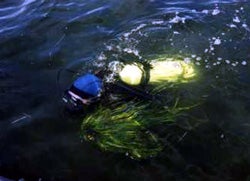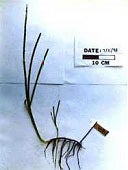 Narragansett, RI — November 24, 2004–The meadows of eelgrass found in lagoons along the Atlantic seacoast have a long history of providing a habitat for fish and invertebrates of many species. Despite this long history, it has proven difficult to document and quantify the relationships between eelgrass cover and the abundance of fish and crabs on a larger scale.
Narragansett, RI — November 24, 2004–The meadows of eelgrass found in lagoons along the Atlantic seacoast have a long history of providing a habitat for fish and invertebrates of many species. Despite this long history, it has proven difficult to document and quantify the relationships between eelgrass cover and the abundance of fish and crabs on a larger scale.
An article in the current issue of the journal Marine Ecology Progress Series describes experiments by URI Graduate School of Oceanography (GSO) biological oceanographers Lora Harris, Betty Buckley, Scott Nixon, and Ben Allen to investigate how different habitats affect predator-prey relationships. The three habitats in the study included eelgrass Zostera marina, macroalgae, and bare sediment.
The study was supported by Rhode Island Sea Grant and carried out in the Lagoon Mesocosm Facility, located at the GSO’s Narragansett Bay Campus.
Mesocosms containing marine sediments, coastal water, and varying densities of eelgrass or macroalgae were used to simulate conditions found in shallow coastal lagoons of Rhode Island. Bluefish, commonly found in Narragansett Bay and Rhode Island salt ponds, were used as predators in each experiment after appropriate acclimation in each habitat type. Prey fish were provided in equally weighted rations and included silversides, tautog, cunner, and menhaden, all species found in local eelgrass meadows and all part of the bluefish diet.
 The scientists found that the presence of eelgrass significantly increased survival of silversides, tautog, and cunner even at very low shoot densities. Experiments using macroalgae did not result in significantly different survival rates between bare sand and macroalgae habitat for silversides or cunner, the two species tested for this vegetation type.
The scientists found that the presence of eelgrass significantly increased survival of silversides, tautog, and cunner even at very low shoot densities. Experiments using macroalgae did not result in significantly different survival rates between bare sand and macroalgae habitat for silversides or cunner, the two species tested for this vegetation type.
“These findings confirm the hypothesis that eelgrass habitats serve a functional role as refuges from predation for some prey fish,” said Harris. “Studies have shown that the more structurally complex a habitat is, the more significant the decline in predation.
“Our results provide better insight into the different habitat value of eelgrass meadows. The findings support a continuation of efforts to protect and manage eelgrass meadows effectively.”
The URI Graduate School of Oceanography is one of the country’s largest marine science education programs, and one of the world’s foremost marine research institutions. Founded in 1961 in Narragansett, RI, GSO serves a community of scientists who are researching the causes of and solutions to such problems as harmful algal blooms, global warming, air and water pollution, oil spills, overfishing, and coastal erosion. GSO is home to the Coastal Institute, the Coastal Resources Center, Rhode Island Sea Grant, the Institute for Archaeological Oceanography, the Pell Marine Science Library, and the National Sea Grant Library.
Photos courtesy of URI Graduate School of Oceanography

